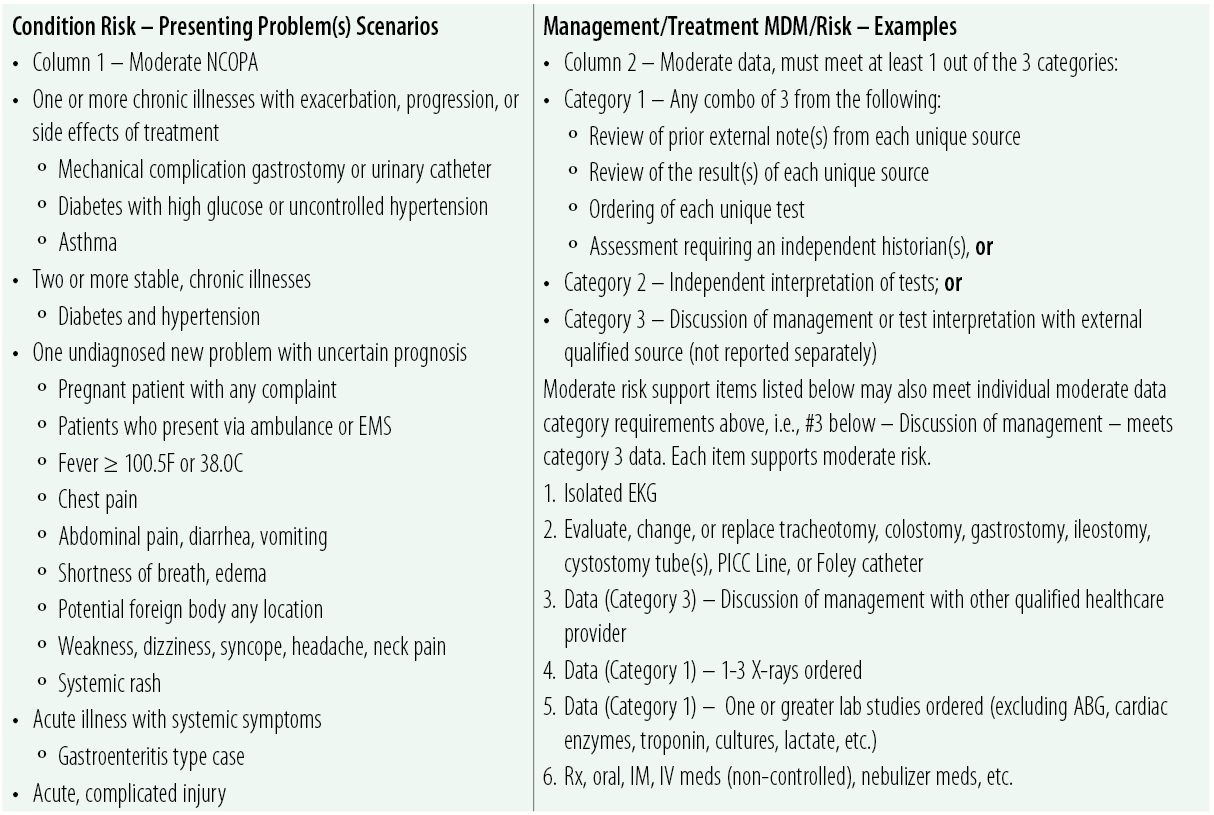Comparing 2023 E/M MDM and Table of Risk
Side by side, the 1995 and 1997 Documentation Guidelines and the 2023 CPT® E/M Services Guidelines aren’t so different.
Some hospitals and coding and billing entities are under the impression that the new 2023 CPT® evaluation and management (E/M) services guidelines and code changes make things much easier for coding, billing, and auditing processes. It appears to me, however, that the American Medical Association’s medical decision-making (MDM) grid is meant to be a general framework for each level of service. Providers must still fill in, classify, or check off certain information in the grid to give coders, billers, auditors, and payers a clear picture of what was done. This isn’t as easy as it may seem, and it is very subjective.
Although ambiguities surrounding the 2023 E/M services guidelines remain, they are in effect today. The Centers for Medicare & Medicaid Services (CMS’) 1995 and 1997 Documentation Guidelines for Evaluation and Management Services (’95/’97 DGs) are no longer in use, including the table of risk.
In this article, we’ll look at the MDM ingredients and sort them out to make E/M code selection more intuitive.
CPT® Risk Description and Relation to the 2023 MDM Grid
Risk is one element used in selecting the level of an E/M service, and CPT® defines the risk of complications and/or morbidity or mortality of patient management/treatment at an encounter as “management and treatment” risk. This is distinct from the level of risk for the “condition of presenting problem(s)” or the “number and complexity of the problem(s) to be addressed” (NCOPA). Therefore, there are two drivers of risk to the patient: management/treatment risk and condition risk.
Below is a comparison of the 2023 E/M MDM grid and table of risk from the ’95/’97 DGs for a visual view of these risk identifiers. The E/M MDM grid and the DG’s table of risk below show how this all fits in with the elements of all patient risks that can be associated with any presenting problem scenario.
Comparison of 2023 E/M MDM Grid and Risk Table
The two tables below show the exact same information, except that which was added to the 2023 MDM grid for low MDM (highlighted).
So far, if the patient has one of the conditions listed on the left, you have already established the level of risk. However, CPT® does not have any risk examples listed for low MDM, and you haven’t yet classified the type of presenting problem(s). That doesn’t mean there aren’t any examples that would fit into any of these categories, however.
With some focus on emergency department (ED) E/M, the American College of Emergency Physicians (ACEP) has stated that ED groups probably would not use this low-risk code since the types of conditions cared for at this level are uncommon in such a setting. These problems would be evaluated without X-rays, testing, or imaging. Thus, it is highly probable that ED groups’ E/M distributions are going to shift significantly to the right, raising red flags and audits to come.
Let’s take this a step further and look at the second or center column of the 2023 MDM grid and compare how risk is assigned with the use of data collection.
Columns 2 and 3 from the DG’s table of risk were combined to show management and treatment risk options and potential data capture (i.e., diagnostic studies, ordered tests, reviews, and interpreted results, discussions, etc.). CPT® does not have any risk examples listed under the low risk level.
When you review the new MDM grid information on the left side, it seems clear that imaging, testing, and other studies are and can be considered. I believe CMS is going to have more to say on this in future rulemaking.
The 2023 E/M Services Guidelines for MDM include some risk examples for both the 99284 and 99285 levels of service. Let’s look at the moderate level of MDM (99284).
The two lists above show the same information, except the one section highlighted in yellow in the table of risk is deleted in the new 2023 MDM grid.
Columns 2 and 3 from the DG’s table of risk were combined in the 2023 E/M guidelines to show management and treatment risk options and potential data capture (i.e., diagnostic studies, ordered tests, reviewed and interpreted results, discussions, etc.).
Moderate MDM Examples as a 2023 E/M Coding Reference Guide
Pulling this all together, Column 1 NCOPA examples have been classified and filled in as presenting problems. Column 2 data can simply be a check off of the applicable data captured based on the encounter activity. Knowing what the provider did for that patient’s problem(s) will also help identify the risk level for the encounter. What tests were ordered and reviewed? What management discussions or interpretations were documented? What medications were administered? And what was the final disposition of the patient? All of this data to be reviewed and analyzed and next steps for management and final disposition of the patient are considered for MDM.
With this comparison view of the E/M MDM framework, it seems to be all based on accurate documentation of an encounter and the ability to reflect the medical services into codes. As with any entity and a new coding process, there is room for improvement and change of process.
Accurate Coding Highlights
The coding process can be achieved using any order/two of the following three MDM elements:
1. Complexity of the problems to be addressed – what kind of problem(s) is being presented?
2. Amount/complexity of data – this is merely a check-off system. Was it done or not? This section also drives the risk complexity of management and treatment. How much was done for the problem(s) addressed?
3. Risk – All risk is tied to the presenting problem(s)/condition risk and how they are managed and treated – management/treatment risk.
Provider Documentation Highlights
Document your review of external notes.
Document the orders and reviews of unique tests.
Document independent historian encounters.
Document independent interpretations of the test(s).
Document discussions of management or test interpretation with other QHP.
Document appropriate descriptive history and exam.
Resources:
AMA. CPT® 2023 Evaluation and Management (E/M) Services Guidelines
ACEP.org/FAQ
AMA E/M Guidelines Changes, July 1, 2022
CMS.gov – 2023 Final Physician Fee Schedule
CMS. 1995 Documentation Guidelines for E/M Services. www.cms.gov/outreach-and-education/medicare-learning-network-mln/mlnedwebguide/downloads/95docguidelines.pdf






